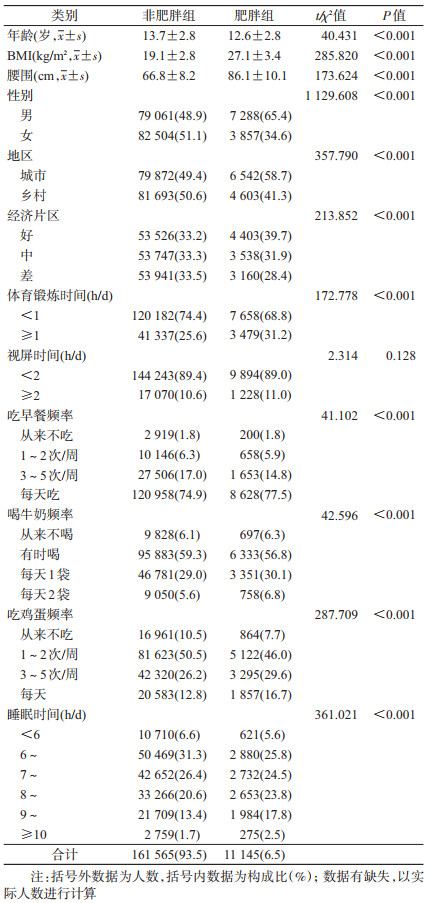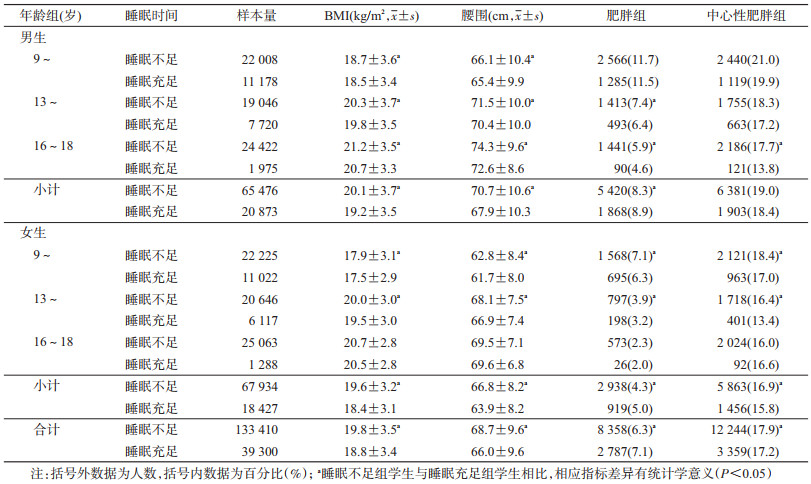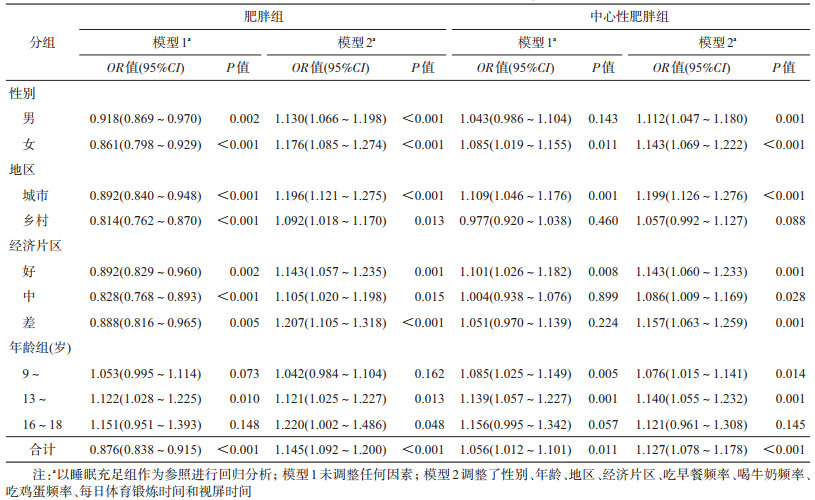文章信息
- 李艳辉, 陶然, 高迪, 温勃, 董彬, 宋逸, 邹志勇, 马军.
- Li Yanhui, Tao Ran, Gao Di, Wen Bo, Dong Bin, Song Yi, Zou Zhiyong, Ma Jun
- 我国儿童青少年睡眠不足与肥胖的关联性研究
- A study on the relationship between insufficient sleep and obesity among children and adolescents in China
- 中华流行病学杂志, 2020, 41(6): 845-849
- Chinese Journal of Epidemiology, 2020, 41(6): 845-849
- http://dx.doi.org/10.3760/cma.j.cn112338-20190711-00514
-
文章历史
收稿日期: 2019-07-11
2017年全球疾病负担报告显示,高BMI显著增加了疾病负担,已成为致死的第四大危险因素[1]。近年来,儿童青少年肥胖和中心性肥胖检出率持续升高,已成为全球公共卫生问题[2-3]。儿童青少年肥胖与全生命周期一系列不健康结局有关,长期肥胖可以增加心脑血管疾病发生和发展的风险[4]。研究发现睡眠持续时间是儿童青少年肥胖的独立影响因素,短睡眠时长可显著增加肥胖发生风险[5]。目前全球儿童青少年普遍缺乏充足的睡眠[6],睡眠不足或许是肥胖率快速上升且居高不下的重要原因。然而睡眠不足与肥胖的关系仍存在争议[7]。本研究利用全国性数据,分析我国儿童青少年睡眠不足与肥胖的关系,以期为儿童青少年肥胖的有效防控提供理论依据,为儿童青少年全面健康发展提供方向。
资料与方法1.资料来源:来源于2014年全国学生体质与健康调研,采用分层随机整群抽样调查方法。具体抽样方案和检测方法见文献[8]。身高、体重、腰围的检测严格按照文献[8]的要求进行,问卷调查包括了睡眠时间、体育锻炼时间、视屏时间等行为习惯信息。本研究选择基本信息和问卷调查资料完整的9~18岁学生为研究对象,排除睡眠时间缺失者5 888人,最终共纳入172 710名学生。
2.研究指标:①睡眠不足:按照美国睡眠医学学会推荐的儿童青少年睡眠量进行判定,9~12岁儿童每日睡眠时间不足9 h,13~18岁青少年每日睡眠时间不足8 h被判定为睡眠不足[9]。②肥胖:儿童青少年肥胖的判定是性别和年龄特异的,根据中国肥胖问题工作组制定的《中国学龄儿童青少年超重、肥胖筛查体重指数值分类标准》中BMI的截断值分性别、分年龄进行肥胖的判定。③中心性肥胖:根据我国卫生行业标准《7~18岁儿童青少年高腰围筛查界值》(WS/T 611-2018)中腰围的截断值分性别、分年龄进行中心性肥胖的判定。
3.调整变量:肥胖影响因素众多,其最直接的原因是摄入量和消耗量的不均衡,儿童青少年个体行为生活方式是肥胖的重要影响因素。研究发现饮食行为和运动时间与超重/肥胖密切相关,如高能量零食、油炸食品、蔬菜水果、早餐、豆及奶制品、含糖饮料等的食用,每日体育锻炼时间和静坐时间等。且不同性别、年龄、地区和经济水平其超重/肥胖检出率存在明显差异。体质调研调查问卷中包括了儿童青少年吃早餐、喝牛奶及吃鸡蛋的频率,体育锻炼时间和视屏时间等对肥胖有影响的因素,因此在分析睡眠不足及睡眠时长对肥胖的影响时,将性别、年龄、地区、经济片区、饮食习惯、体育锻炼时间和视屏时间作为协变量进行调整。
4.统计学分析:采用SPSS 24.0软件进行统计学分析,BMI、腰围等计量资料采用x±s的形式表示,睡眠时间、体育锻炼时间等分类资料采用频数(%)的形式表示。采用t检验比较两组间均数的差异,采用χ2检验比较两组间率的差异。采用logistic回归分析我国儿童青少年睡眠不足与肥胖的关系,并按性别、地区、年龄段和经济片区分层分析睡眠不足对儿童青少年肥胖影响的稳定性。以P<0.05为差异有统计学意义。
结 果1.基本特征:共调查172 710名学生,其中,肥胖者有11 145人,肥胖率为6.5%(表 1)。男生和城市地区的肥胖率较高,且经济状况越好,肥胖率越高。睡眠不足的学生共133 410人(77.2%);女生睡眠不足率(78.7%)高于男生(75.8%),高中生睡眠不足率(93.8%)高于初中生(74.2%)和小学生(66.6%)。睡眠不足者平均有6.3%的学生检出肥胖,17.9%的学生检出中心性肥胖。
2.儿童青少年睡眠时间与肥胖的关系:睡眠不足学生的BMI和腰围高于睡眠充足学生,男女生呈现相同的结果。睡眠不足学生中男生肥胖检出率为8.3%,女生为4.3%。睡眠不足组男生中心性肥胖检出率为19.0%,女生为16.9%。分年龄段分析,小学、初中和高中睡眠不足组肥胖检出率分别为9.3%、5.6%和4.1%,睡眠不足组中心性肥胖检出率分别为19.7%、17.3%和16.8%。同时考虑性别和年龄,结果显示,除高中女生外,其他各年龄段男、女生的BMI和腰围均为睡眠不足组高于睡眠充足组。中学男生和小学、初中女生睡眠不足组肥胖和中心性肥胖检出率更高(表 2)。
3.儿童青少年睡眠不足与肥胖发生风险的关系:未调整任何因素时,睡眠不足对肥胖具有保护作用。控制混杂因素后,多因素回归分析结果显示,与睡眠充足组学生相比,睡眠不足组学生发生肥胖的风险增加14.5%(OR=1.145,95%CI:1.092~1.200),发生中心性肥胖的风险增加12.7%(OR=1.127,95%CI:1.078~1.178)。按照性别、地区、经济片区和年龄段分层分析,发现睡眠不足均增加儿童青少年肥胖和中心性肥胖的发生风险。在女生、城市学生中,睡眠不足与肥胖发生风险的关联效应值更高。且随着年龄的增长,睡眠不足学生发生肥胖和中心性肥胖的风险更大(表 3)。
调整混杂因素后,与每日睡眠时间<6 h者相比,睡眠时间≥7 h者发生肥胖的风险更低,睡眠时间≥6 h者发生中心性肥胖的风险更低。且随着睡眠时间的增长,其发生风险均显著降低(趋势检验P<0.001)。男、女生呈现相同趋势,睡眠时间为7~10 h可显著降低肥胖和中心性肥胖的发生风险。见图 1。

|
| 注:以睡眠时间<6 h/d组作为参照,调整性别、年龄、地区、经济片区、吃早餐频率、喝牛奶频率、吃鸡蛋频率、每日体育锻炼时间和视屏时间 图 1 儿童青少年不同睡眠持续时间发生肥胖的风险 |
本研究发现睡眠不足学生发生肥胖和中心性肥胖的风险更大,与大部分研究一致[10-11]。部分研究未发现儿童青少年睡眠持续时间与肥胖的关系[12-13],可能原因是样本量太小,未控制与肥胖相关的重要变量或者睡眠时间分组不当等。有研究提示不同性别和年龄其睡眠时间对肥胖的影响不同[14],本研究未发现性别或年龄与睡眠时间存在交互作用对肥胖和中心性肥胖产生不同影响。在分层分析中,发现女生、城市学生和高年级学生睡眠不足发生肥胖的风险更高,因此在实际工作中应加强对该群体的关注,提前采取预防措施。
睡眠不足导致肥胖的机制可能是:睡眠时间过短导致食欲调节激素异常,引起饥饿感,促进进食[15];短睡眠时间也可能增强大脑与快乐和奖励相关的中枢神经活动,促进高脂肪食物摄入[16];同时,可降低大脑皮层食欲评价区的反应性,增加了摄入高能量食物的欲望[17];睡眠时间不足也可能增加视屏时间,减少体力活动时间,促进肥胖的发生[18]。本研究观察到睡眠不足学生每日视屏时间更长,体育锻炼≥1 h的比例更低。
研究发现儿童青少年更易感于睡眠不足的不良影响,即相对于成年人,儿童青少年睡眠不足发生肥胖的风险更大[19],提示应更加关注儿童青少年睡眠不足问题。目前我国乃至全世界学生睡眠不足情况严峻,若针对睡眠不足采取措施防治肥胖的发生发展,则潜力巨大,收益甚广。研究发现增加睡眠时长可以降低食欲,减少体重的增长[20],这为儿童青少年肥胖防控提供了新的方向和曙光。
本研究基于全国数据,发现我国儿童青少年睡眠不足其肥胖和中心性肥胖发病风险增加,为肥胖有效防控提供了依据和目标。但由于学生睡眠状况甚忧,未能捕捉到睡眠时间过长的学生。未来应分析睡眠时间过长对学生肥胖的影响,以确定合适、健康的睡眠时长。
利益冲突 所有作者均声明不存在利益冲突
| [1] |
GBD 2017 Risk Factor Collaborators. Global, regional, and national comparative risk assessment of 84 behavioural, environmental and occupational, and metabolic risks or clusters of risks for 195 countries and territories, 1990-2017:a systematic analysis for the Global Burden of Disease Study 2017[J]. Lancet, 2018, 392(10159): 1923-1994. DOI:10.1016/S0140-6736(18)32225-6 |
| [2] |
NCD Risk Factor Collaboration (NCD-RisC). Worldwide trends in body-mass index, underweight, overweight, and obesity from 1975 to 2016:a pooled analysis of 2416 population-based measurement studies in 128·9 million children, adolescents, and adults[J]. Lancet, 2017, 390(10113): 2627-2642. DOI:10.1016/S0140-6736(17)32129-3 |
| [3] |
Hardy LL, Mihrshahi S, Gale J, et al. 30-year trends in overweight, obesity and waist-to-height ratio by socioeconomic status in Australian children, 1985 to 2015[J]. Int J Obes (Lond), 2017, 41(1): 76-82. DOI:10.1038/ijo.2016.204 |
| [4] |
Reis JP, Loria CM, Lewis CE, et al. Association between duration of overall and abdominal obesity beginning in young adulthood and coronary artery calcification in middle age[J]. JAMA, 2013, 310(3): 280-288. DOI:10.1001/jama.2013.7833 |
| [5] |
Miller MA, Kruisbrink M, Wallace J, et al. Sleep duration and incidence of obesity in infants, children, and adolescents:a systematic review and Meta-analysis of prospective studies[J]. Sleep, 2018, 41(4): 1-19. DOI:10.1093/sleep/zsy018 |
| [6] |
Wheaton AG, Jones SE, Cooper AC, et al. Short sleep duration among middle school and high school students-United States, 2015[J]. MMWR Morb Mortal Wkly Rep, 2018, 67(3): 85-90. DOI:10.15585/mmwr.mm6703a1 |
| [7] |
Thind H, Davies SL, Lewis T, et al. Does short sleep lead to obesity among children and adolescents? Current understanding and implications[J]. Am J Lifestyle Med, 2015, 9(6): 428-437. DOI:10.1177/1559827614533911 |
| [8] |
全国学生体质与健康调研组. 2014全国学生体质与健康调研工作手册[M]. 北京: 高等教育出版社, 2014. National Students Constitution and Health Research Group. 2014 Chinese National Survey on Students Constitution and Health Research Workbook[M]. Beijing: Higher Education Press, 2014. |
| [9] |
Paruthi S, Brooks LJ, D'Ambrosio C, et al. Recommended amount of sleep for pediatric populations:a consensus statement of the american academy of sleep medicine[J]. J Clin Sleep Med, 2016, 12(6): 785-786. DOI:10.5664/jcsm.5866 |
| [10] |
Sakamoto N, Gozal D, Smith DL, et al. Sleep duration, snoring prevalence, obesity, and behavioral problems in a large cohort of primary school students in Japan[J]. Sleep, 2017, 40(3). DOI:10.1093/sleep/zsw082 |
| [11] |
Ji MM, Tang A, Zhang YF, et al. The relationship between obesity, sleep and physical activity in Chinese preschool children[J]. Int J Environ Res Public Health, 2018, 15(3): 527. DOI:10.3390/ijerph15030527 |
| [12] |
Chaput JP, Leduc G, Boyer C, et al. Objectively measured physical activity, sedentary time and sleep duration:independent and combined associations with adiposity in Canadian children[J]. Nutr Diabetes, 2014, 4(6): e117. DOI:10.1038/nutd.2014.14 |
| [13] |
Morita N, Kambayashi I, Okuda T, et al. Inverse relationship between sleep duration and cardio-ankle vascular index in children[J]. J Atheroscl Thromb, 2017, 24(8): 819-826. DOI:10.5551/jat.36517 |
| [14] |
Cao MQ, Zhu YN, He BT, et al. Association between sleep duration and obesity is age- and gender-dependent in Chinese urban children aged 6-18 years:a cross-sectional study[J]. BMC Public Health, 2015, 15: 1029. DOI:10.1186/s12889-015-2359-0 |
| [15] |
St-Onge MP, Grandner MA, Brown D, et al. Sleep duration and quality:impact on lifestyle behaviors and cardiometabolic health:a scientific statement from the american heart association[J]. Circulation, 2016, 134(18): e367-386. DOI:10.1161/CIR.0000000000000444 |
| [16] |
St-Onge MP. Sleep-obesity relation:underlying mechanisms and consequences for treatment[J]. Obes Rev, 2017, 18(Suppl 1): 34-39. DOI:10.1111/obr.12499 |
| [17] |
Greer SM, Goldstein AN, Walker MP. The impact of sleep deprivation on food desire in the human brain[J]. Nat Commun, 2013, 4: 2259. DOI:10.1038/ncomms3259 |
| [18] |
Hart CN, Hawley N, Davey A, et al. Effect of experimental change in children's sleep duration on television viewing and physical activity[J]. Pediatr Obes, 2017, 12(6): 462-467. DOI:10.1111/ijpo.12166 |
| [19] |
Bayon V, Leger D, Gomez-Merino D, et al. Sleep debt and obesity[J]. Ann Med, 2014, 46(5): 264-272. DOI:10.3109/07853890.2014.931103 |
| [20] |
Tasali E, Chapotot F, Wroblewski K, et al. The effects of extended bedtimes on sleep duration and food desire in overweight young adults:a home-based intervention[J]. Appetite, 2014, 80: 220-224. DOI:10.1016/j.appet.2014.05.021 |
 2020, Vol. 41
2020, Vol. 41





